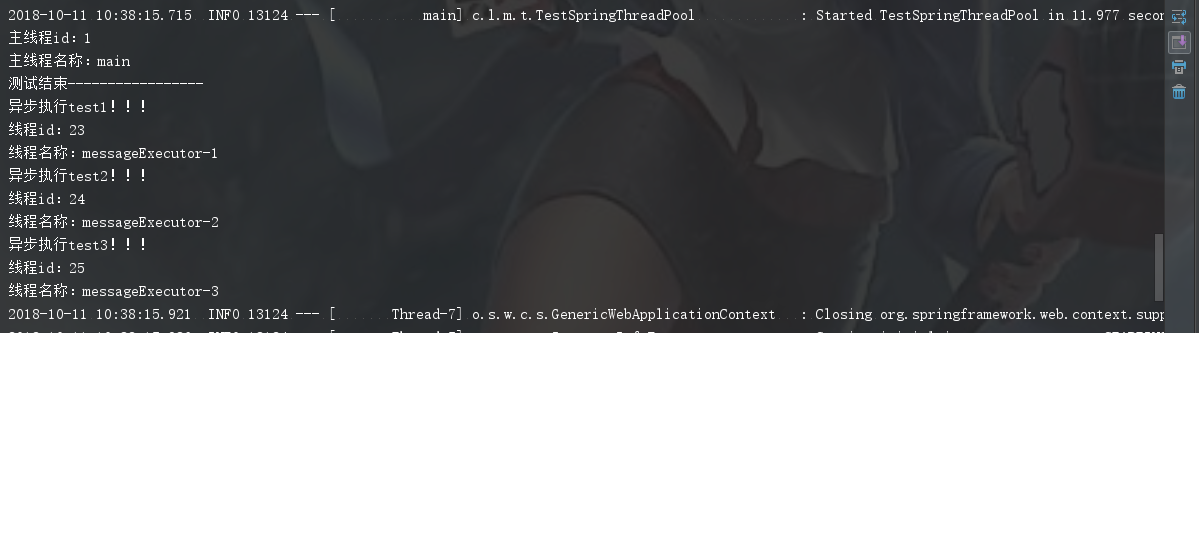最近公司项目正逐渐从dubbo向springCloud转型,在本次新开发的需求中,全部使用springcloud进行,在使用时线程池,考虑使用spring封装的线程池,现将本次使用心得及内容记录下来
一、线程池常规使用方式
之前使用线程池的方式,都是自己定义线程池,然后写多线程类,用线程池去调用,如下:
package cn.leadeon.message.client; import cn.leadeon.comm.log.Log; import cn.leadeon.message.req.MessageProducerReq; import lombok.Data; import java.util.concurrent.ExecutorService; import java.util.concurrent.Executors; /** * 流量消息发送类,线程池调用 * * @author LiJunJun * @since 2018/9/30 */ @Data public class MessageClientSendMsg { /** * 日志记录器 */ private static final Log LOGGER = new Log(MessageClientSendMsg.class); /** * 线程池 */ private static ExecutorService threadPool; /** * trace */ private String trace; /** * 手机号 */ private String cellNum; /** * 消息实体 */ private MessageProducerReq messageProducerReq; static { threadPool = Executors.newFixedThreadPool(10); } /** * 构造函数 * * @param trace 请求流水 * @param cellNum 电话号码 * @param messageProducerReq 消息实体 */ public MessageClientSendMsg(String trace, String cellNum, MessageProducerReq messageProducerReq) { this.trace = trace; this.cellNum = cellNum; this.messageProducerReq = messageProducerReq; } /** * 消息发送 */ public void sendMsg() { SendMsgRunable sendMsgRunable = new SendMsgRunable(); threadPool.execute(sendMsgRunable); } /** * 发送消息内部类并处理异常,不能影响主线程的业务 */ class SendMsgRunable implements Runnable { @Override public void run() { try { MessageClientProducer msgClintProducer = new MessageClientProducer(); msgClintProducer.sendAsyncWithPartition(trace, cellNum, messageProducerReq); } catch (Exception e) { LOGGER.error("消息发送失败!,trace:" + trace); } } } }
二、使用spring的线程池
- 线程池的启用
有两种方式,配置文件或者注解
注解:使用@EnableAsync标注启用spring线程池,@Async将方法标注为异步方法,spring扫描到后,执行该方法时,会另起新线程去执行,非常简单
package cn.leadeon.message.test; import org.springframework.scheduling.annotation.Async; import org.springframework.scheduling.annotation.EnableAsync; import org.springframework.stereotype.Component; /** * @author LiJunJun * @since 2018/10/11 */ @Component @EnableAsync public class AsyncTest { @Async public void test1() { System.out.println("异步执行test1!!!"); System.out.println("线程id:" + Thread.currentThread().getId()); System.out.println("线程名称:" + Thread.currentThread().getName()); } @Async public void test2() { System.out.println("异步执行test2!!!"); System.out.println("线程id:" + Thread.currentThread().getId()); System.out.println("线程名称:" + Thread.currentThread().getName()); } @Async public void test3() { System.out.println("异步执行test3!!!"); System.out.println("线程id:" + Thread.currentThread().getId()); System.out.println("线程名称:" + Thread.currentThread().getName()); } }
配置文件:新增spring的配置文件spring-threadpool.xml
<?xml version="1.0" encoding="UTF-8"?> <beans xmlns="http://www.springframework.org/schema/beans" xmlns:xsi="http://www.w3.org/2001/XMLSchema-instance" xmlns:aop="http://www.springframework.org/schema/aop" xmlns:tx="http://www.springframework.org/schema/tx" xmlns:jdbc="http://www.springframework.org/schema/jdbc" xmlns:context="http://www.springframework.org/schema/context" xmlns:mvc="http://www.springframework.org/schema/mvc" xmlns:task="http://www.springframework.org/schema/task" xsi:schemaLocation="http://www.springframework.org/schema/context http://www.springframework.org/schema/context/spring-context-3.1.xsd http://www.springframework.org/schema/beans http://www.springframework.org/schema/beans/spring-beans-3.1.xsd http://www.springframework.org/schema/jdbc http://www.springframework.org/schema/jdbc/spring-jdbc-3.1.xsd http://www.springframework.org/schema/tx http://www.springframework.org/schema/tx/spring-tx-3.1.xsd http://www.springframework.org/schema/aop http://www.springframework.org/schema/aop/spring-aop-3.1.xsd http://www.springframework.org/schema/task http://www.springframework.org/schema/task/spring-task.xsd" default-autowire="byName"> <description>流量消息spring线程池配置</description> <!-- 缺省的异步任务线程池 --> <task:annotation-driven executor="messageExecutor"/> <task:executor id="asyncExecutor" pool-size="100-10000" queue-capacity="10"/> <!-- 处理message的线程池 --> <task:executor id="messageExecutor" pool-size="15-50" queue-capacity="100" keep-alive="60" rejection-policy="CALLER_RUNS"/> </beans>
使用注解引入配置文件或者在自己的spring配置文件中import即可
package cn.leadeon.message.test; import org.springframework.context.annotation.ImportResource; import org.springframework.scheduling.annotation.Async; import org.springframework.stereotype.Component; /** * @author LiJunJun * @since 2018/10/11 */ @Component @ImportResource("classpath:/config/spring-threadpool.xml") public class AsyncTest { @Async public void test1() { System.out.println("异步执行test1!!!"); System.out.println("线程id:" + Thread.currentThread().getId()); System.out.println("线程名称:" + Thread.currentThread().getName()); } @Async public void test2() { System.out.println("异步执行test2!!!"); System.out.println("线程id:" + Thread.currentThread().getId()); System.out.println("线程名称:" + Thread.currentThread().getName()); } @Async public void test3() { System.out.println("异步执行test3!!!"); System.out.println("线程id:" + Thread.currentThread().getId()); System.out.println("线程名称:" + Thread.currentThread().getName()); } }
配置文件可以自己配置线程池的相关参数,自己可以配置多个线程池,使用时,用@Async(value="beanId")区分即可
注意点:
@EnableAsync注解与<task:annotation-driven executor="messageExecutor"/>等价,两者只能使用其一,不然启动会报错
- java编程方式配置自定义线程池,如下:
package cn.leadeon.message.base.threadpool; import org.springframework.beans.factory.annotation.Value; import org.springframework.context.annotation.Bean; import org.springframework.context.annotation.Configuration; import org.springframework.scheduling.concurrent.ThreadPoolTaskExecutor; import java.util.concurrent.Executor; import java.util.concurrent.ThreadPoolExecutor; /** * 流量消息线程池配置 * * @author LiJunJun * @since 2018/10/10 */ @Configuration public class ThreadPoolConfiguration { /** * 核心线程数:线程池创建时候初始化的线程数 */ @Value("${executor.core.pool.size}") private int corePoolSize; /** * 最大线程数:线程池最大的线程数,只有在缓冲队列满了之后才会申请超过核心线程数的线程 */ @Value("${executor.max.pool.size}") private int maxPoolSize; /** * 缓冲队列200:用来缓冲执行任务的队列 */ @Value("${executor.queue.capacity}") private int queueCapacity; /** * 允许线程的空闲时间(单位:秒):当超过了核心线程出之外的线程在空闲时间到达之后会被销毁 */ @Value("${executor.keepalive.Seconds}") private int keepAliveSeconds; /** * 线程池名的前缀:设置好了之后可以方便我们定位处理任务所在的线程池 */ @Value("${executor.thread.name.prefix}") private String threadNamePrefix; @Bean public Executor MessageExecutor() { ThreadPoolTaskExecutor executor = new ThreadPoolTaskExecutor(); executor.setCorePoolSize(corePoolSize); executor.setMaxPoolSize(maxPoolSize); executor.setQueueCapacity(queueCapacity); executor.setKeepAliveSeconds(keepAliveSeconds); executor.setThreadNamePrefix(threadNamePrefix); // 线程池对拒绝任务的处理策略:这里采用了CallerRunsPolicy策略,当线程池没有处理能力的时候,该策略会直接在 execute 方法的调用线程中运行被拒绝的任务;如果执行程序已关闭,则会丢弃该任务 executor.setRejectedExecutionHandler(new ThreadPoolExecutor.CallerRunsPolicy()); executor.initialize(); return executor; } }
- 测试
package cn.leadeon.message.test; import org.junit.Test; import org.springframework.beans.factory.annotation.Autowired; /** * spring线程池单元测试 * * @author LiJunJun * @since 2018/10/11 */ public class TestSpringThreadPool extends JunitTestBase { @Autowired private AsyncTest asyncTest; /** * spring线程池单元测试 */ @Test public void testThreadPool() { System.out.println("主线程id:" + Thread.currentThread().getId()); System.out.println("主线程名称:" + Thread.currentThread().getName()); asyncTest.test1(); asyncTest.test2(); asyncTest.test3(); } }
测试结果:主线程和异步方法分别使用了不同的线程去调用,测试完成






















 6981
6981











 被折叠的 条评论
为什么被折叠?
被折叠的 条评论
为什么被折叠?








